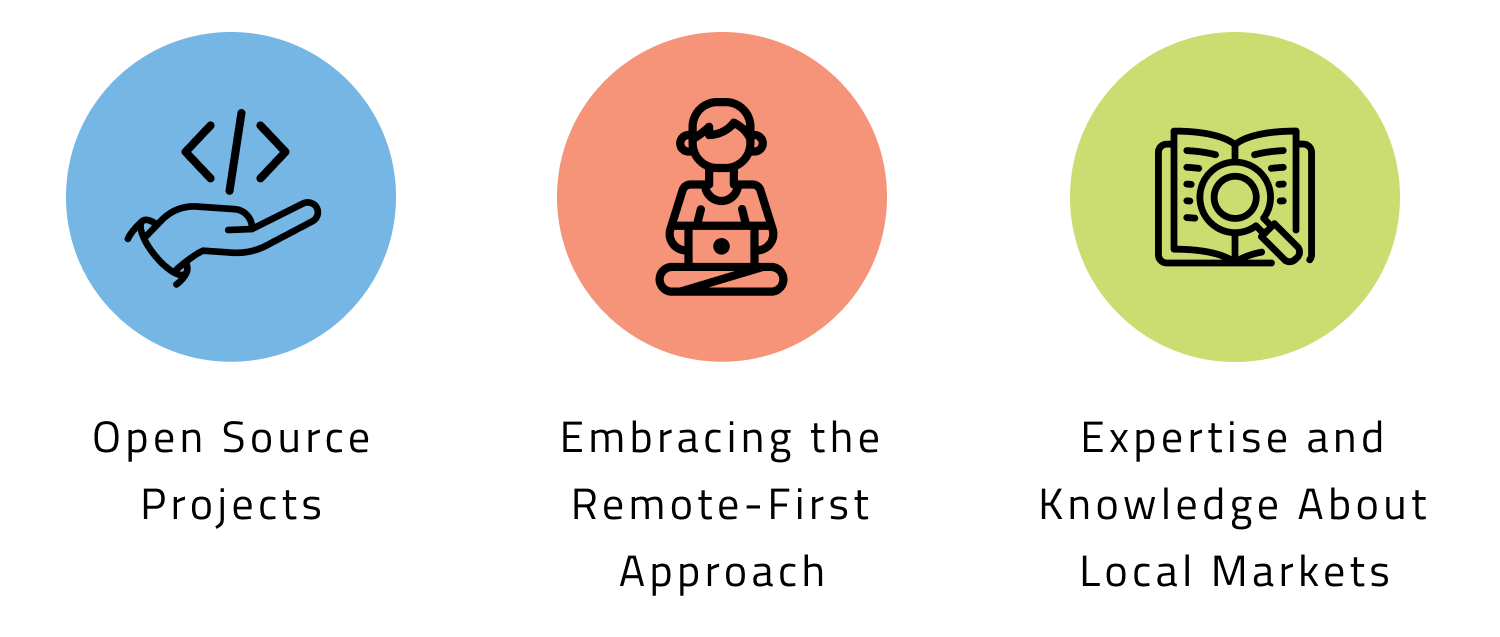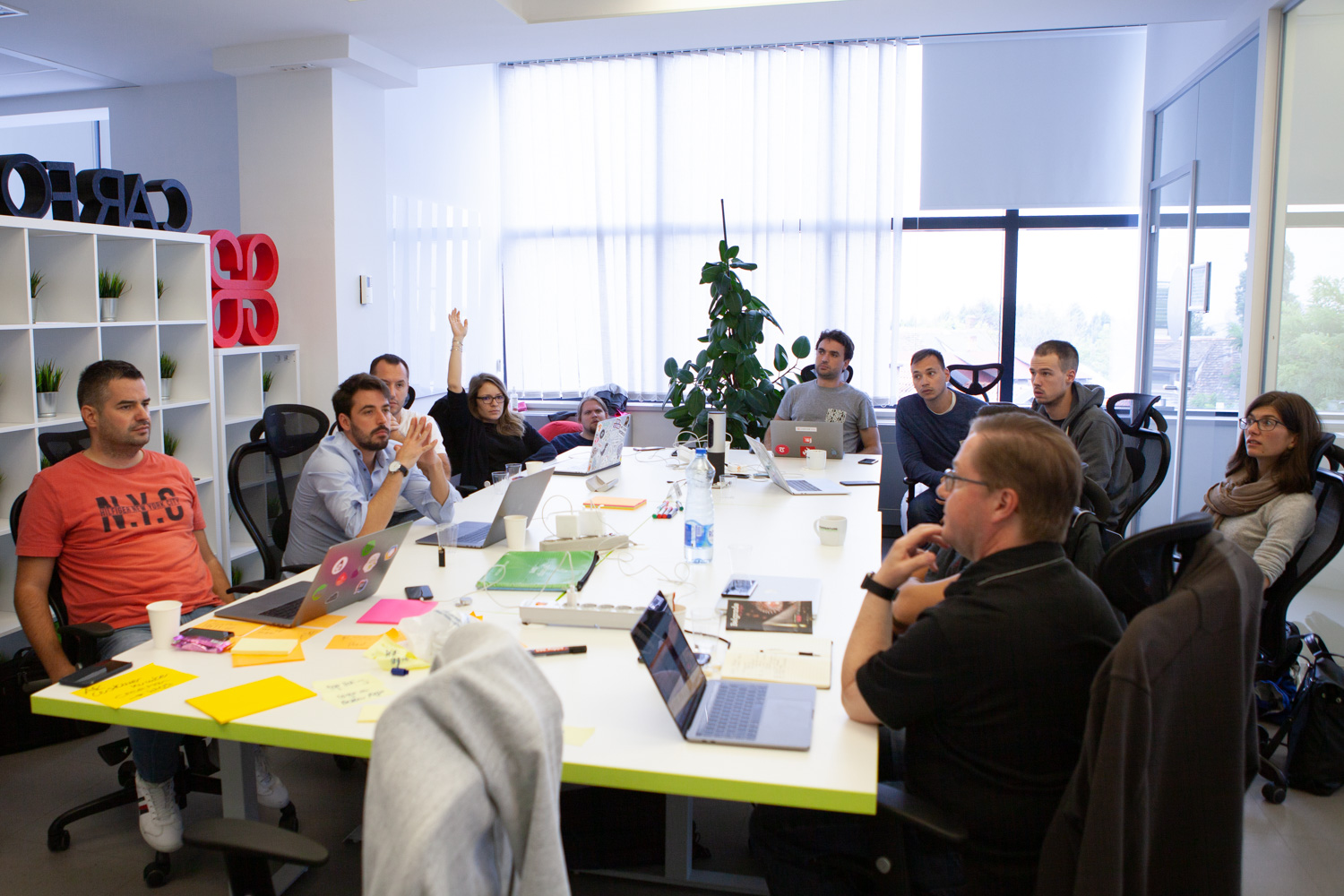Distributed teams are reshaping the global IT industry
Posted by InterVenture on August 20, 2020In the early eighties, humanity entered the computer age and never looked back.
Back then, Microsoft, IBM, Intel, and Apple were recognized as the pioneers shaping the future of tech. Hardware and software were developed at an incredible pace, which impacted our everyday lives in inconceivable fashion.
For the first time ever, personal computers entered the market as affordable devices intended for single non-technical users. This democratization of technology was such a crucial event that the Time magazine named ‘The Computer as the Machine of the Year’, thus breaking its long tradition of announcing ‘The Man of the Year’. This was huge.

One man-created object got rightfully recognized as the jumping-off point for our collective progress. By the end of the decade, personal computers entered households around the world and pushed typewriters and carbon copies out of the offices.
It’s borderline fascinating to observe how one thing leads to another and how generations of people work together for innovation, like bees. Standing on the shoulders of giants, as they say.
Further experimentation, collective breakthroughs, and cumulative experiences brought us the Internet, which turned our world into a global village. In such a landscape, the global IT industry thrives precisely because talented people are enabled to seamlessly collaborate across the planet.
The way we work has become far more important than where we work.
Yes, we’re talking about distributed teams. Here’s how they are reshaping IT.
Understanding distributed teams
Distributed teams work remotely around the world instead of being centralized in a single physical office. This means they work from different locations using technology and tools for collaboration.
Some categorizations (like this one from Remote How) imply a distinction between distributed, hybrid, split, and fully remote teams.
| Distributed teams | People who collaborate remotely, but typically work from physical offices that are scattered across various locations around the world. |
| Hybrid teams | Mixed teams, made of people who work both from physical offices and remotely. |
| Split teams | The team is usually split into two different locations. People work either from their homes or from co-working spaces/hubs. |
| Fully remote teams | Teams are in no way bound by the office and work together from any desired location. |
In addition to these terms, you may have heard of teleworkers, which is basically a synonym for remote workers.
Now, the above-mentioned categorization might seem like splitting hairs, especially because these definitions often overlap in reality.
In the business world, phrases ‘distributed teams’ and ‘remote teams’ are used interchangeably because in a nutshell – they both imply a collaboration between at least two groups of people that are not co-located.
Distributed teams bring diversity to IT
The Internet helped us shift our focus from the traditional work system (which is office-based) to a remote work system (which is talent-based).
But before we dive in deeper to show how distributed teams shape the global IT industry, let’s take a brief trip to the past to illustrate our point.
Interestingly enough, distributed teams are not new. In fact, they’ve been around for centuries.
John O’Duinn, the author of ‘Distributed Teams: The Art and Practice of Working Together While Physically Apart’, discussed how distributed teams always existed. From the great Portuguese explorer Magellan and its crew to generals in the Battle of Waterloo – there are plenty of examples.
Believe it or not, but distributed teams can be traced all the way back to the Middle Ages. This was the time of great decentralization. Most important spheres of life such as politics, culture, education, and business, were all distributed across multiple centers. Medieval Europe relied on flexible networks to collaborate and communicate across the continent.
Authority was not centralized, but this didn’t cause chaos. In fact, scholars argue that specifically because of this decentralization and the freedom and flexibility it brought, Europe went through a massive economic expansion. Population and productivity rapidly increased, and this ‘economic renaissance’ created a healthy foundation for scientific research.
So, why do distributed teams matter? Why have they always mattered?
Two main reasons: flexibility and diversity.

Individuals from different locations bring to the table their unique experiences, perspectives, expertise, knowledge, methodologies, and more. But they do so when they feel they have enough space and autonomy to do great work.
How we think is shaped by so many factors – from the type of education and support we had to the culture we are a part of. Studies have shown that diversity is the key to innovative and successful teams because it stimulates creative brainstorming and helps us move forward. In IT (software engineering in particular), this is of paramount importance.
Of course, distributed teams are not diverse by default. But, as O’Duinn points out, in most cases – they tend to be.
Distributed teams have supercharged the global IT growth
In the traditional work setting, office spaces are seen as necessary facilitators of great relationships, and irreplaceable components of ‘making things happen’. The premise is, people have to be physically in the room to effectively collaborate and come up with something brilliant.
Today, many challenge this idea even to the extent of calling offices distractors and a complete waste of both time and money. Distributed teams are somewhere in between. They might work from the office, but the office is not required. You can say they take the best of both worlds.
Here are a few examples of the way distributed teams supercharge global growth of IT.

Distributed IT teams and individuals around the world contribute to open source projects. This exchange of ideas is one of the main reasons why we have so many useful frameworks that make the coding experience much more pleasant. Progress is community-driven, it’s fast, and it’s beneficial on multiple levels.
Distributed IT teams and individuals around the world contribute to open source projects. This exchange of ideas is one of the main reasons why we have so many useful frameworks that make the coding experience much more pleasant. Progress is community-driven, it’s fast, and it’s beneficial on multiple levels.
Because there is literally a battle for talent in tech, the social contract has changed. Many professionals are looking for project-based work. There is a lot of fluctuation in IT and job-hopping has become normal – not just because of the financial reasons, but also because of developers’ thirst for new challenges and the fear of falling into a skill rot.
Leading IT companies know that the world can become their talent pool, regardless of whether they’re looking for developers who are specialists or generalists. Distributed teams are a sure way to increase the speed to market, but it’s not that easy to assemble good ones.
Distributed teams are redefining insourcing

Modern distributed teams are changing the way we think about the dynamics and opportunities of international collaboration. In fact, for us at InterVenture, distributing teams are redefining what insourcing means. Here’s what it’s all about.
IT outsourcing has gained a bad reputation for many reasons. Its nature is very transactional and driven primarily by cost-savings, not quality or desire to innovate.
In contrast to that, high-quality and carefully selected distributed teams become a part of the existing, core team. The relationship is fundamentally different and this reflects both on the development process, efficiency, the overall team morale, and end results.
At InterVenture, we believe in the new concept of insourcing.
By definition, insourcing means the company uses its own resources to finish a task or handle a certain workload that was previously outsourced. For us, insourcing is about ‘drawing talent in’, i.e. expanding/augmenting your team with people who are not physically by your side, but with whom you can grow.
This is why we created the Own Team Model™ that brings you a 100% dedicated team service that consists of the core engineering team, a branded office space in our incubator-like engineering center, and your committed success manager. We designed this ecosystem to help people partner up and do amazing work together. Your team gets integrated into your engineering department and the communication runs smoothly – just like with your on-site employees.
Another service we offer is Ready Team Model™ which is perfect in case you need a temporary help from A-star software teams. With this model, the only thing you’ll be outsourcing is your worries. This is a great option in case you need teams that are specializing in your technology of choice. Instead of wasting your time interviewing and researching freelancers across some of hiring platforms, you simply tell InterVenture what kind of project you want to complete and we’ll find the perfect, experienced, and reliable team for you from our Ready Team Model™ network.
Want to see the Own Team Model™ and Ready Team Model™ in action? We have a lot of amazing success stories: feel free to explore our base of partners to get a bigger picture and discover the magic that happens when the right people are brought together.
To wrap up, we can all agree that new technologies and socioeconomic changes brought us a unique opportunity to make the most of the distributed teams in the 21st century; far better than our ancestors ever could have imagined, don’t you think?
If you want to find out more about what we at InverVenture do differently and how we’re building a successful global network of partners, get in touch with us today. We’re happy to hear from you.


